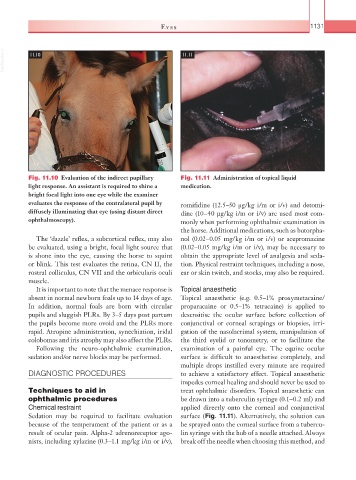Page 1156 - Equine Clinical Medicine, Surgery and Reproduction, 2nd Edition
P. 1156
Eyes 1131
VetBooks.ir 11.10 11.11
Fig. 11.10 Evaluation of the indirect pupillary Fig. 11.11 Administration of topical liquid
light response. An assistant is required to shine a medication.
bright focal light into one eye while the examiner
evaluates the response of the contralateral pupil by romifidine (12.5–50 µg/kg i/m or i/v) and detomi-
diffusely illuminating that eye (using distant direct dine (10–40 µg/kg i/m or i/v) are used most com-
ophthalmoscopy). monly when performing ophthalmic examination in
the horse. Additional medications, such as butorpha-
The ‘dazzle’ reflex, a subcortical reflex, may also nol (0.02–0.05 mg/kg i/m or i/v) or acepromazine
be evaluated, using a bright, focal light source that (0.02–0.05 mg/kg i/m or i/v), may be necessary to
is shone into the eye, causing the horse to squint obtain the appropriate level of analgesia and seda-
or blink. This test evaluates the retina, CN II, the tion. Physical restraint techniques, including a nose,
rostral colliculus, CN VII and the orbicularis oculi ear or skin twitch, and stocks, may also be required.
muscle.
It is important to note that the menace response is Topical anaesthetic
absent in normal newborn foals up to 14 days of age. Topical anaesthetic (e.g. 0.5–1% proxymetacaine/
In addition, normal foals are born with circular proparacaine or 0.5–1% tetracaine) is applied to
pupils and sluggish PLRs. By 3–5 days post partum desensitise the ocular surface before collection of
the pupils become more ovoid and the PLRs more conjunctival or corneal scrapings or biopsies, irri-
rapid. Atropine administration, synechiation, iridal gation of the nasolacrimal system, manipulation of
colobomas and iris atrophy may also affect the PLRs. the third eyelid or tonometry, or to facilitate the
Following the neuro-ophthalmic examination, examination of a painful eye. The equine ocular
sedation and/or nerve blocks may be performed. surface is difficult to anaesthetise completely, and
multiple drops instilled every minute are required
DIAGNOSTIC PROCEDURES to achieve a satisfactory effect. Topical anaesthetic
impedes corneal healing and should never be used to
Techniques to aid in treat ophthalmic disorders. Topical anaesthetic can
ophthalmic procedures be drawn into a tuberculin syringe (0.1–0.2 ml) and
Chemical restraint applied directly onto the corneal and conjunctival
Sedation may be required to facilitate evaluation surface (Fig. 11.11). Alternatively, the solution can
because of the temperament of the patient or as a be sprayed onto the corneal surface from a tubercu-
result of ocular pain. Alpha-2 adrenoreceptor ago- lin syringe with the hub of a needle attached. Always
nists, including xylazine (0.3–1.1 mg/kg i/m or i/v), break off the needle when choosing this method, and

